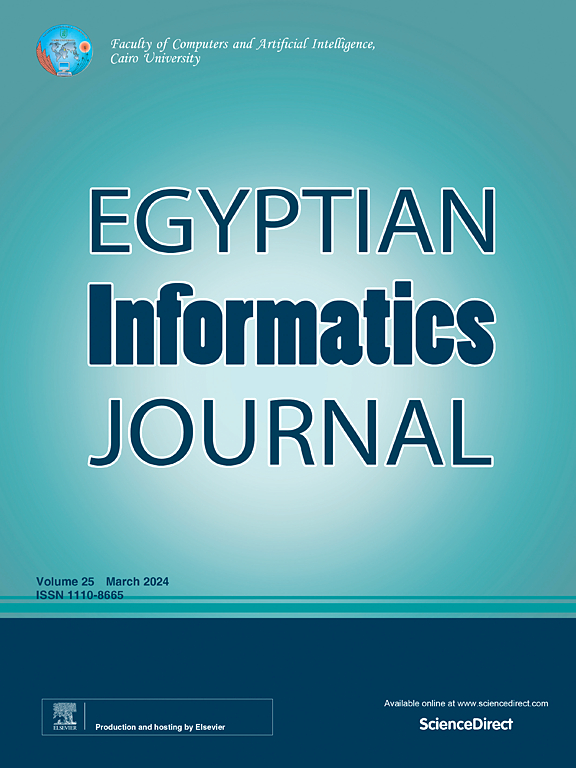Badminton actions detection from sensor data based on Deep Belief network optimized by Advanced Snake optimizer
IF 4.3
3区 计算机科学
Q1 COMPUTER SCIENCE, ARTIFICIAL INTELLIGENCE
引用次数: 0
Abstract
Badminton is a kind of racquet sport which has fast and accurate movements that highlights the need for badminton action’s automatic identification within training, sport analysis, and coaching. However, the identifying actions of badminton from sensor data is difficult according to the complex nature of human actions. Such movement identification systems focus on general activities like sitting, walking, and running rather than actions that are badminton-specific. Also, the badminton players’ sensor data show different measures that makes the traditional feature normalization methods useless. This study presents a new approach for badminton action identification through use of DBNs or Deep Belief Networks, which are optimized by the ASO or snake optimizer’s improved version. The proposed DBN/ASO model is tested on the Badminton Sensor Dataset (BSS), which includes 25 players performing 10 types of strokes (1,140 samples). The model performed satisfactorily in experiments, achieving 93.2 % accuracy, 94.1 % sensitivity, 92.3 % precision, 93.8 % specificity, 93.2 % F1-score, and a Matthews Correlation Coefficient (MCC) of 0.915, surpassing CNN/LSTM, MM-AGNES, NDT-GCN, 3D:VIBE, and Multi-Sensor (M−S) state-of-the-art model performances. AUC = 0.92 from the Receiver Operating Characteristic (ROC) analysis, confirms its strong discriminative ability. Comparatively benchmarking on CEC test functions ASO has yielded the mean best fitness 9.12e−7 on F1 (Sphere) and 1.43e−3 on F2 (Rosenbrock), associated with the lowest standard deviation across all functions, thus demonstrating better convergence and robustness. This substantiates the efficacy of the proposed framework for the accurate recognition of complex badminton actions from wearable sensor data, in turn laying down a pathway for intelligent coaching and real-time performance analytics.
基于深度信念网络的羽毛球动作检测,基于高级Snake优化器
羽毛球是一种运动速度快、动作准确的球拍运动,这就突出了在训练、运动分析和教练中对羽毛球动作自动识别的需求。然而,由于人类动作的复杂性,从传感器数据中识别羽毛球动作是困难的。这种运动识别系统侧重于一般的活动,如坐、走和跑,而不是特定于羽毛球的动作。此外,羽毛球运动员的传感器数据显示出不同的度量,使得传统的特征归一化方法无效。本研究提出了一种新的羽毛球动作识别方法,即使用基于深度信念网络的羽毛球动作识别方法,该方法由ASO或snake优化器的改进版本进行优化。DBN/ASO模型在羽毛球传感器数据集(BSS)上进行了测试,该数据集包括25名运动员进行10种击球(1,140个样本)。该模型在实验中表现令人满意,准确率为93.2%,灵敏度为94.1%,精度为92.3%,特异性为93.8%,f1评分为93.2%,马修斯相关系数(MCC)为0.915,超过了CNN/LSTM, MM-AGNES, NDT-GCN, 3D:VIBE和多传感器(M−S)最先进的模型性能。受试者工作特征(ROC)分析AUC = 0.92,证实了其较强的判别能力。相对而言,对CEC测试函数ASO进行基准测试得到F1 (Sphere)上的平均最佳适应度为9.12e−7,F2 (Rosenbrock)上的平均最佳适应度为1.43e−3,所有函数的标准差最低,因此具有较好的收敛性和鲁棒性。这证实了所提出的框架在从可穿戴传感器数据中准确识别复杂羽毛球动作方面的有效性,从而为智能教练和实时性能分析奠定了基础。
本文章由计算机程序翻译,如有差异,请以英文原文为准。
求助全文
约1分钟内获得全文
求助全文
来源期刊

Egyptian Informatics Journal
Decision Sciences-Management Science and Operations Research
CiteScore
11.10
自引率
1.90%
发文量
59
审稿时长
110 days
期刊介绍:
The Egyptian Informatics Journal is published by the Faculty of Computers and Artificial Intelligence, Cairo University. This Journal provides a forum for the state-of-the-art research and development in the fields of computing, including computer sciences, information technologies, information systems, operations research and decision support. Innovative and not-previously-published work in subjects covered by the Journal is encouraged to be submitted, whether from academic, research or commercial sources.
 求助内容:
求助内容: 应助结果提醒方式:
应助结果提醒方式:


